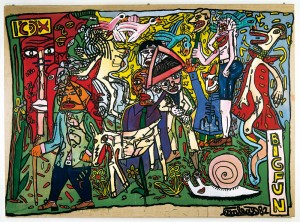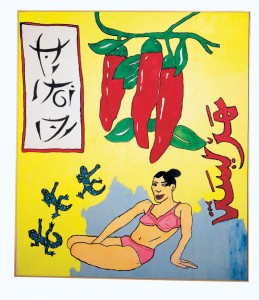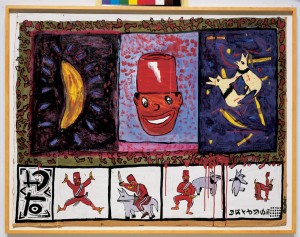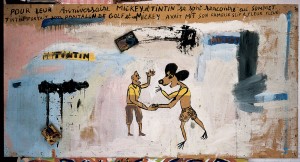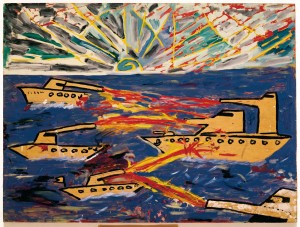How can I explain “figuration libre” (free figuration), since I am its creator?
I will quote an author, unknown yet, one of these rare writers that can be “free figurative”: Michel Zoom. The scene: two men meet, one of them tells the other one: “I caught that egg disease”, the second man answers in astonishment: “well, and what is that ?”. The former says “Nothing, I just want to be ill !”. That is Figuration Libre text. Michel Zoom is influenced by jokes, slang, and poetry. As for me, a canvas can be influenced by naive African advertisements, schoolbook illustrations, these can be mixed up with Picasso or Miro, or even with a cartoon drawing, and then you add to that made-up arabic writings, and some “Art Brut” like Dubuffet or Cobra. “Figuration Libre” is a way of painting that denies neither its primitive instincts, nor a desire for culture.
Like Jules Vernes, I went to Tombouctou, without going out of my home.
At first, my painting was called “fun painting”. But I didn’t like that because it was an English word. I did not give my painting a name because I was the only to have such a style. Anyhow, at the Academy, I nicknamed it “fun painting”, because it really was something fun. I still call it “funny and relaxed” painting, which means the same thing. For the exhibition “Finir en Beauté” (Finishing in Beauty), at the Bernard Lamarche-Vadel Gallery, Paris, the art critic thought that we ought to be larger in number, so that we could be much stronger. Actually, that was more to help the other artists to get famous, because I was already selling quite well. Eventually, Ben found the name “Figuration Libre”, and everyone was happy to use it, just like an advertising sponsor.
Figuration libre
Figuration Libre, it’s about doing what we want, as much as we can, as personnally and as freely as possible.
Figuration Libre, is about enjoying yourself, being relaxed,just having fun !.
Figuration Libre is not about “I can draw pretty well”, or “I can do it better than they do”.
Figuration Libre is about using all means, without any shame, in order to improve one’s work if there is any need.
Figuration Libre is about colouring one’s bad drawing, hiding the imperfections with black paint, and highlight the colours and the forms with black outlines.
Figuration Libre is when I start drawing cartoons with a funny hero and the morning after I drop it to paint the Waterloo battle on a gigantic canvas.
I am not Hergé, nor Andy Warhol, nor any of these great painters who remain prisoners of a certain form of painting in an established order, and who only change every six years, and some of them do no even change during lifetime. Life is about changing. We change our car, our wife, ours socks, our underpants. So we have to change more often our painting, drawing, ideas. One day we are precise, the day after completely undisciplined, well-done, badly-done. Being oneself. We can take, a coffee in the neighbourg’s garden, but not his wife, nor their destiny.
My painting is rock n’ roll music, the search for Feeling. The Feeling is rhythm, it is the mad drummer in the jungle and voodoo dances, it is the Rolling Stones who imitated the old songs of black bluesmen and created a new music without knowing it. For me, it’s the same with painting, feeling the rhythm of calligraphy on Chinese, Arabic, and Mediterranean painted advertisements.
Dadaisme, Art Brut, Negro Art, advertising painters from Haiti, from Africa, South America and Jamaica, Naive Art, l’Arte Povera, Rock and Roll, the whole Rock Culture thing, Art of the Misfits (people with Down’s Syndrome…), Picasso, Expressionnism, Impressionism, cartoon comics. You mix everything and you find Combas, figurative, yes, because I live in a world of realities. However I find the message of my paintings to be completly abstract. It is a mixture of images, of colours, of fake Asian, Arabic and Latino calligraphy, it is a form of painting that aspires toward a universal language.
![[EN] Combas.com](https://www.combas.com/en/wp-content/uploads/sites/3/2016/01/logo-reseau.png)
